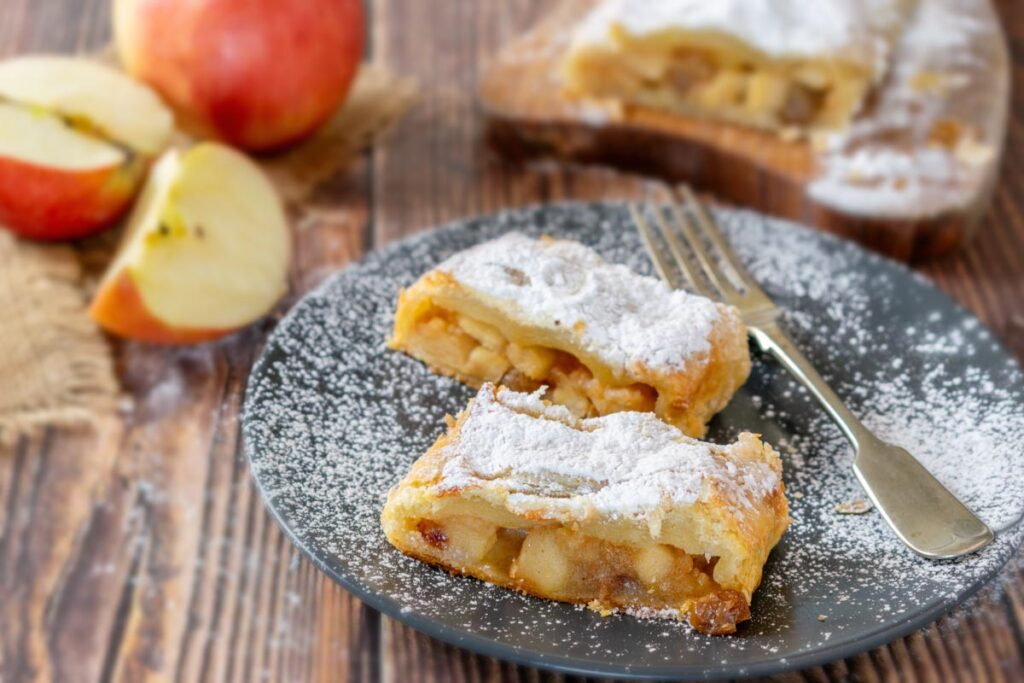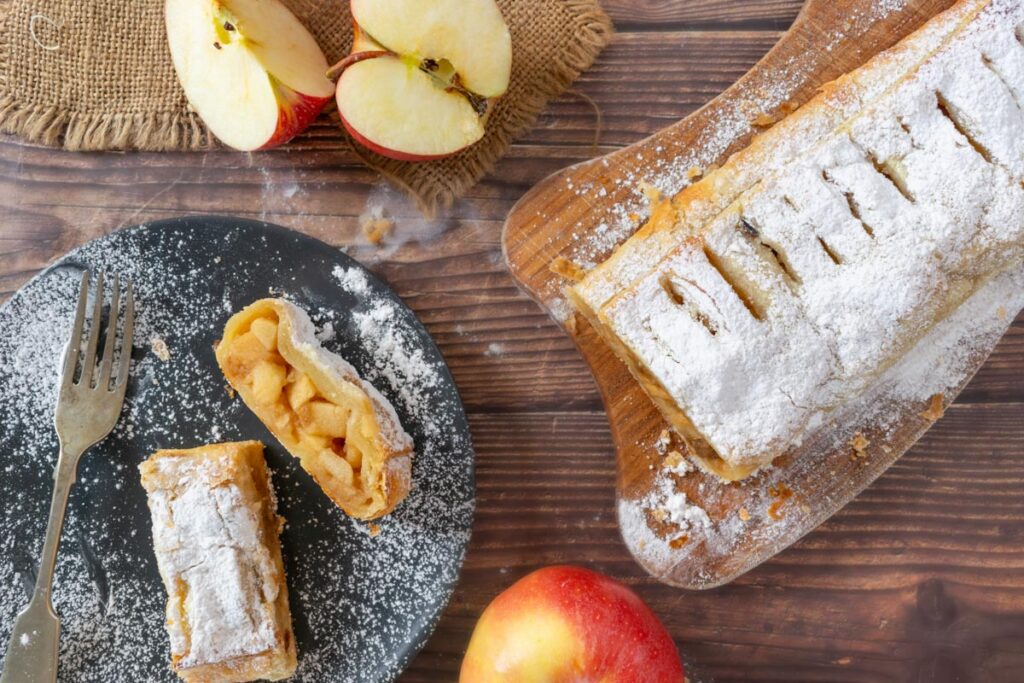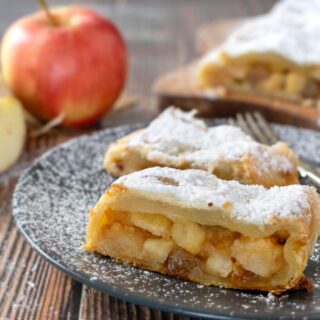Craving an authentic taste of Italy? Discover the timeless tradition of the Italian classic apple strudel, a delectable pastry steeped in centuries of cultural exchange. Indulge in the irresistible flavors of apples, raisins, pine nuts, and cinnamon.
Apple strudel is a classic pastry from the Alto Adige tradition consisting of a thin flaky dough and a filling of apples, raisins, pine nuts, and cinnamon flavoring. Strudel is also prepared according to various local customs of Northern Italy, with different fillings that include savory versions using meat or vegetables. The dough envelope is stretched very thin and filled, then rolled up and baked until the dough is crisp and golden brown. Regional variations result in many unique and delicious types of strudel across Northern Italian communities. Apple strudel remains one of the most iconic and widely recognized pastry dishes associated with the cuisine of this alpine region.
History and Origins of Italian Apple Strudel
Alpine Roots
The history of strudel can be compared to a long intercontinental journey. Its spread across Europe resulted from numerous commercial exchanges and culinary influences. The earliest records of this dessert were found in some Asian documents: an Assyrian manuscript from the 8th century BC described a fine meal composed of layers of pastry or unleavened bread, nuts, and honey; this combination later became very popular in other Mesopotamian kingdoms over subsequent centuries. Thanks to the Silk Road, the dessert arrived in Greece in the 3rd century BC and then in Turkey, inspiring the creation of two recipes: künefe (a light pastry made with corn starch, milk, pomegranate seeds, walnuts, and rose water, consumed especially during Ramadan) and baklava (where phyllo dough layered with butter and soaked in a lemon, honey, and spice syrup envelops a luscious filling of nuts; see the article for more details).
In 1526, with territorial expansion led by Sultan Suleiman the Magnificent, this stratified masterpiece also entered Hungary, which would remain under Ottoman Empire rule for almost 200 years. Here, bakers likely began adding apples and substituting pine nuts for walnuts; from that point onward the basic recipe underwent various transformations, but the 6th century marked a turning point between use of the Turkish phyllo dough made with water and flour without added fats, and the emergence of the “pasta matta” dough widely used today in Europe, which owes its friable consistency to oil.
Over a century later, with Austria’s conquest of Hungary in 1699, the dessert began to be appreciated in Viennese aristocratic salons; thus this “popular” fine pastry became a noble dish, and the raw materials used were enriched with the addition of raisins macerated in liqueur. The first detailed text on the preparation process dates to 1827 and appears in Anna Dorn’s Great Book of Viennese Cooking, where it is called Apfelstrudel (literally “apple whirlwind”: an expression that well conveys the idea).

Cultural Fusion
As you explore the origins of this delectable pastry, you’ll discover that the strudel’s popularity in South Tyrol is a testament to the area’s multicultural past. The dessert, originally an Austrian specialty, found its way into Italian cuisine through centuries of cultural exchange and shifting borders. This fusion of culinary traditions has resulted in a distinctly Italian interpretation of the classic strudel.
Evolution of Ingredients
The Italian apple strudel has evolved to incorporate local ingredients that set it apart from its Austrian counterpart. You’ll find that South Tyrolean apples, renowned for their crisp texture and balanced sweetness, take center stage in this dessert. The addition of pine nuts, a staple in Italian cuisine, further distinguishes the Italian version. Over time, variations emerged, showcasing the versatility of this beloved pastry and reflecting regional preferences.
As you savor a slice of Italian apple strudel, you’re not just indulging in a delicious dessert; you’re partaking in a rich culinary history that spans centuries and crosses cultural boundaries.
What Apples Should I use in Trentino Apple Strudel?
The apples I chose for this recipe are Renette apples, which are truly the queens of baking. They contain a reduced amount of water but know that they are not only excellent for baking or turning into fritters, but are also perfect for eating raw and especially healthy, thanks to a higher amount of antioxidants compared to other apples.
You should also know that the more common but still very tasty “Golden Delicious” variety will also work well for preparing your strudel.
Italian Apple Strudel Video Recipe
Authentic Apple Strudel Recipe
The name “strudel” means “vortex”, referring to the dough that wraps the apples in multiple layers. Raisins, pine nuts and cinnamon complete the traditional recipe that each family or chef revisits, varies and personalizes.
Apple strudel is an irresistible dessert, perfect for serving at a savory snack or concluding a Sunday lunch. It can be presented alongside vanilla custard or whipped cream, either plain or flavored with cinnamon. The light and flaky pastry layered with sautéed apples and spices makes for a satisfying sweet. Apple strudel’s simple ingredients come together to create a treat that will have everyone asking for seconds. Whether as an afternoon pick-me-up or festive finish to a holiday feast, apple strudel brings warmth and comfort through its familiar flavors.
Classic Apple Strudel Ingredients
For the Pastry:
- 150 g all-purpose flour (1¼ cups)
- 40 g butter (¼ stick plus 1 tbsp)
- 2 g salt (1 tsp)
- 20 g sugar (1 tbsp plus 2 tsp)
- 80 ml lukewarm water (⅓ cup)
For the Filling:
- 700 g Rennette apples (1 lb 8¾ oz)
- 50 g raisins (⅓ cup) softened and squeezed dry
- 30 g pine nuts (3 tbsp plus 2 tsp)
- 1 lemon
- Ground cinnamon to taste
- Ground cloves to taste
- 20 g butter (1 tbsp plus 2 tsp)
- 80 g sugar (⅓ cup plus 1 tbsp)
- 30 g breadcrumbs (⅔ cup plus 1 tbsp)
To Complete:
- Melted butter
- Powdered sugar to garnish
Prepare the Dough
To create the apple strudel, begin by preparing the dough. In a mixing bowl, combine the flour with the lukewarm water, butter, sugar and salt. You can mix this by hand or with a stand mixer fitted with the paddle attachment, mixing until combined and finishing with the dough hook. The result should be a smooth, elastic dough. Form it into a ball and let it rest at room temperature for 30 minutes in a covered bowl.
Create the Filling
While the dough rests, prepare your filling. Peel and cube the apples, then transfer them to a bowl. Add raisins, pine nuts, lemon juice, cinnamon and cloves. You can add the cloves by finely grating just the rounded part of the seed and not the stem. Mix everything together well and let it rest at room temperature.
In a non-stick pan, melt butter with sugar. Add the breadcrumbs and brown them. Once ready, transfer to a bowl to cool.
Assemble the Strudel
Roll out your dough to 1 cm thickness on a tea towel, without using extra flour. Continue rolling with your hands to 2 mm in this way: thin it out with the tips of your fingers, pulling it outward and being careful not to tear it.
Combine the apple mix with the breadcrumb mix and spread this filling over the dough, leaving a border. Using the towel, carefully roll the dough around the filling. Fold in the ends and brush with water to seal.
Bake and Serve
Transfer the strudel to a parchment-lined baking sheet, compacting it with your hands to give it a regular shape. Make small incisions on the surface and brush with melted butter. Bake at 180°C (356°F) for about 40 minutes. Once cooled, dust with powdered sugar.

Serving Suggestions and Variations for Italian Apple Strudel
Classic Presentation
When serving your Italian apple strudel, present it on a decorative platter dusted with powdered sugar. Slice it diagonally into 1-2 inch pieces to showcase the spiral layers. For an authentic experience, serve the strudel slightly warm, accompanied by a scoop of vanilla ice cream or a dollop of unsweetened whipped cream.
Creative Variations
While the traditional apple filling is beloved, you can experiment with other fruits and flavors:
- Pear and Gorgonzola: Replace apples with ripe pears and add crumbled Gorgonzola for a sweet-savory twist.
- Cherry and Almond: Substitute cherries for apples and add slivered almonds for extra crunch.
- Fig Strudel: see here my recipe.
- Savory Strudel: Create a hearty main course by filling the pastry with spinach, ricotta, and prosciutto.
Accompaniments and Pairings
Enhance your strudel experience with these complementary items:
- Drizzle with warm caramel or vanilla sauce for added indulgence.
- Serve alongside a cup of espresso or cappuccino for a true Italian touch.
- For a festive occasion, pair with a glass of sweet Moscato d’Asti or a locally produced grappa.
Remember, while variations can be delightful, the classic Italian apple strudel remains a timeless favorite, cherished for its simplicity and comforting flavors.

Italian Classic Apple Strudel: A Popular Dessert From Alto Adige Region
Ingredients
For the Dough:
- 150 g all-purpose flour
- 40 g butter
- 2 g salt
- 20 g sugar
- 80 ml lukewarm water
For the Filling:
- 700 g Rennette apples
- 50 g raisins softened and squeezed dry
- 30 g pine nuts
- 1 lemon juice
- Ground cinnamon to taste
- Ground cloves to taste
- 20 g butter
- 80 g sugar
- 30 g breadcrumbs
To Complete:
- Melted butter
- Powdered sugar
Instructions
- In a mixing bowl, combine the flour with the lukewarm water, butter, sugar and salt. You can mix this by hand or with a stand mixer fitted with the paddle attachment, mixing until combined and finishing with the dough hook. The result should be a smooth, elastic dough.
- Form it into a ball and let it rest at room temperature for 30 minutes in a covered bowl.
- While the dough rests, prepare your filling. Peel and cube the apples, then transfer them to a bowl.
- Add raisins, pine nuts, lemon juice, cinnamon and cloves. You can add the cloves by finely grating just the rounded part of the seed and not the stem. Mix everything together well and let it rest at room temperature.
- In a non-stick pan, melt butter with sugar. Add the breadcrumbs and brown them. Once ready, transfer to a bowl to cool.
- Roll out your dough to 1 cm thickness on a tea towel, without using extra flour. Continue rolling with your hands to 2 mm in this way: thin it out with the tips of your fingers, pulling it outward and being careful not to tear it.
- Combine the apple mix with breadcrumb mix.
- Spread this filling over the dough, leaving a border. Using the towel, carefully roll the dough around the filling. Fold in the ends and brush with water to seal.
- Preheat your oven to 180 °C (356 °F).
- Transfer the strudel to a parchment-lined baking sheet, compacting it with your hands to give it a regular shape. Make small incisions on the surface and brush with melted butter.
- Bake for about 40 minutes until golden brown.
- Remove from the oven and let it cool. Once cooled, dust with powdered sugar.
- Serve the strudel slightly warm, accompanied by a scoop of vanilla ice cream or a dollop of unsweetened whipped cream.







